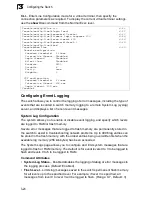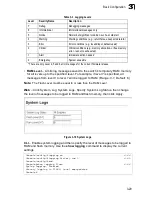
Configuring the Switch
3-42
3
To send an inform to a SNMPv2c host, complete these steps:
1.Enable the SNMP agent (page 3-54).
2.Enable trap informs as described in the following pages.
3.Create a view with the required notification messages (page 3-53).
4.Create a group that includes the required notify view (page 3-49).
To send an inform to a SNMPv3 host, complete these steps:
1.Enable the SNMP agent (page 3-54).
2.Enable trap informs as described in the following pages.
3.Create a view with the required notification messages (page 3-53).
4.Create a group that includes the required notify view (page 3-49).
5.Specify a remote engine ID where the user resides (page 3-44).
6.Then configure a remote user (page 3-47).
Command Attributes
•
Trap Manager Capability
– This switch supports up to five trap managers.
•
Current
– Displays a list of the trap managers currently configured.
•
Trap Manager IP Address
– IP address of a new management station to receive
notification messages.
•
Trap Manager Community String
– Specifies a valid community string for the
new trap manager entry. Though you can set this string in the Trap Managers table,
we recommend that you define this string in the SNMP Configuration page (for
Version 1 or 2c clients), or define a corresponding “User Name” in the SNMPv3
Users page (for Version 3 clients). (Range: 1-32 characters, case sensitive)
•
Trap UDP Port
– Specifies the UDP port number used by the trap manager.
•
Trap Version
– Indicates if the user is running SNMP v1, v2c, or v3. (Default: v1)
•
Trap Security Level
– When trap version 3 is selected, you must specify one of
the following security levels. (Default: noAuthNoPriv)
-
noAuthNoPriv
– There is no authentication or encryption used in SNMP
communications.
-
AuthNoPriv
– SNMP communications use authentication, but the data is not
encrypted (only available for the SNMPv3 security model).
-
AuthPriv
– SNMP communications use both authentication and encryption (only
available for the SNMPv3 security model).
•
Trap Inform
– Notifications are sent as inform messages. Note that this option is
only available for version 2c and 3 hosts. (Default: traps are used)
-
Timeout
– The number of seconds to wait for an acknowledgment before
resending an inform message. (Range: 0-2147483647 centiseconds;
Default: 1500 centiseconds)
-
Retry times
– The maximum number of times to resend an inform message if
the recipient does not acknowledge receipt. (Range: 0-255; Default: 3)
Summary of Contents for 24/48 10/100 Ports + 2GE
Page 2: ......
Page 4: ...ES3526XA ES3552XA F2 2 6 3 E122006 CS R02 149100005500H...
Page 18: ...Contents xiv...
Page 22: ...Tables xviii...
Page 26: ...Figures xxii...
Page 34: ...Introduction 1 8 1...
Page 44: ...Initial Configuration 2 10 2...
Page 242: ...Configuring the Switch 3 198 3...
Page 498: ...Software Specifications A 4 A...
Page 511: ......
Page 512: ...ES3526XA ES3552XA E122006 CS R02D 149100005500H...
















































